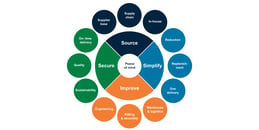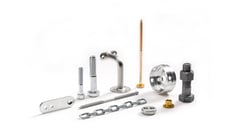- Insights
- The Solutionists Hub
- Sustainable C-Parts: What You Need to Know
Sustainable C-Parts: What You Need to Know

In my experience, manufacturing companies and their purchasers often overlook the importance of C-parts, particularly in terms of the total costs they can generate. At first glance, C-parts are small, inexpensive and simple components like nuts, bolts, screws and other types of small products. However, when they’re not managed correctly, they can quickly pose a threat to a company’s production and bottom line.
Many companies also overlook C-parts when it comes to sustainability. Thankfully, many manufacturers have realized the importance of sustainability in recent years – but most of their focus is often placed on their facilities, manufacturing processes and the A- and B-parts they use in their products.
In my view, they should give the same attention to their C-parts. Although it seems like they have a minor effect on a company’s overall sustainability, the nature of C-parts supply chains and purchasing practices means they actually have a major role to play.
In this article, I'll cover some of these C-parts sustainability issues, and provide some more general information on how sustainability relates to C-parts from a wider viewpoint. Hopefully, it’ll help you realize that if you want to make your company more sustainable and resilient in the face of the future business environment, you can’t afford to ignore C-parts.
There will be more attention on emissions generated by C-parts
Sustainability has been a real megatrend for manufacturers for some years, but as awareness continues to grow and new demands are placed on businesses, they now need to clearly show the actual environmental impact of their operation and how they plan to reduce it in the future. Many different areas contribute, but emissions reporting is the foundation. However, some emissions are easier to report than others. For example, it’s fairly simple for a company to look at the electricity consumed at their office and calculate the amount of carbon this generates. However, finding the total emissions output of a single component, from the moment the raw material is mined to the delivery of the finished product to their factory, is a huge challenge. Things get even more complicated with C-parts, where companies typically deal with many different suppliers who may have very different production and logistics processes.
Despite the difficulties of emissions reporting, manufacturers will need to find a solution. Uncovering your current emissions is a prerequisite for reducing them, which will become more and more essential as emissions regulations broaden and consumers turn away from polluting companies.
The rise of sustainable materials in C-parts
It’s common to see consumer brands promoting the sustainability of the materials used in their products – for example, recycled cotton in clothes or recycled paper in product packaging. So far, very few manufacturers talk about using bolts, nuts, screws and washers made from sustainable materials, but this could change in the future.
Historically, a lack of infrastructure and unoptimized recycling methods made recycling of industrial materials difficult. Aluminum, for example, is a highly recyclable material, like most metals. However, different alloys and surface treatments make the recycling process problematic. But as the market for recycled materials grows and techniques get better, the price and quality of recycled aluminum will improve, and as market demand for sustainable products grows, it could become a viable material for C-parts. Similar developments are ongoing in the world of plastic, and quality is growing here too – so it’s possible that recycled plastic could be a potential material for your plastic C-parts in the near future.
Other advances in sustainable materials, such as green steel production, have great future potential for both large and small components. Once the market matures, companies that promote their use of these materials in even their smallest C-parts will have an opportunity to set themselves apart from their competitors.
Sustainability regulations will have a major impact on manufacturers
Manufacturing companies that deal with C-parts will have more regulations to contend with in the future. These regulations will require a change in manufacturers’ C-parts supply chains, making unsustainable practices even more troublesome and costly.
The main regulation that European manufacturers must be aware of is the EU’s Corporate Sustainability Reporting Directive (CSRD), which will require almost all large companies in the union to ”disclose information on their risks and opportunities arising from social and environmental issues, and on the impacts of their activities on the environment.”
In practice, sustainability reporting will be brought to the same level as standard financial reporting. The companies covered by the directive will have to report on, among other things:
- Their sustainability targets, and their progress so far
- Their sustainability policies
- Information on the business’s operations, relationships, and supply chain
The CSRD is already in force, and the new rules will apply during the financial year 2024. Additional regulations, such as more anti-dumping laws and emissions-based tariffs on goods produced outside the EU, will follow.
Manufacturers that are lagging with their sustainability work will have to quickly start analyzing their supply chain and internal sustainability efforts closely, particularly in their C-parts operation. Common issues surrounding C-parts, such as unoptimized inventories, fragmented supplier bases and high minimum order quantities, all increase the risks of unsustainable practices gaining a foothold within the company. To minimize the negative effects of these new regulations, companies that don’t have control over their C-parts will have to reprioritize their efforts and start managing their C-parts better.
Pressure from owners, shareholders and the market will grow
As regulations like these continue to be implemented and customers’ expectations change, manufacturers will face greater external pressure to prioritize sustainability, and the pressure will come from multiple directions. As sustainability increasingly becomes a direct factor in a company’s financial performance and profitability, companies’ shareholders and group ownership will want to see changes made. And as customers themselves begin to see sustainability as a major factor in their buying decisions, unsustainable companies will see their competitors start to gain ground. This effect may be even more dramatic for B2B manufacturers, whose customers have sustainability targets and KPIs that must be met, as well as owners and shareholders of their own who are keen to see the business become more sustainable.
Sustainable innovators will open new C-parts possibilities
While C-parts made of sustainable materials may not be an everyday reality yet, the work of innovative companies will make them a more feasible choice in the future. For example, companies like Borealis and INEOS Group are developing chemical and mechanical plastic recycling processes that can produce recycled material with the same high quality as virgin plastic. Recycled material could also be a real choice for plastic C-parts in demanding applications.
Other manufacturers are making sustainability a core part of their marketing communications. Volvo Cars, for example, has committed to using recycled plastic for at least 25% of the plastic parts in their vehicles by 2025. As the pace of innovation increases, we may see other manufacturers making similar claims about the metals and plastics used in their C-parts.
My colleagues at Bufab have written multiple articles explaining why you should start giving your C-parts the attention they deserve. When not managed properly, they can cause costs to escalate and efficiency to plummet. I hope this article has shown that they can cause as much damage to your company’s sustainability when handled incorrectly as any A- or B-part.
Get the sustainability trends guide
If you're interested in going further into this topic, you can download our guide to sustainability trends below. It focuses specifically on the most relevant trends for manufacturers that deal with C-parts, and it aims to get you informed on the most pressing topics that will soon have an impact on your business.
Get new knowledge every week!
Related
-
By Sergio BrambilaSustainability targets and KPIs to implement in the purchasing department
-
By Kadi MeriväljaC-Parts Purchasing: Handling Your Sustainable Purchasing Policy
-
By Patrik Lundström TörnquistSustainability Challenges With C-Parts, and How to Manage Them
-
By Niklas LindsköldCBAM: How will it affect European manufacturers?
-
By Niklas LindsköldHuman rights due diligence: Is your supply chain under control?
-
By Niklas LindsköldChemical compliance: What manufacturing companies need to know
-
By Niklas LindsköldConflict minerals: How to avoid them in your manufacturing operation










